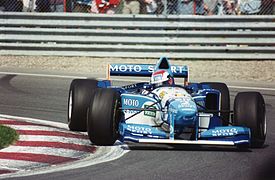Benetton B195
 | |||||||||
| Category | Formula One | ||||||||
|---|---|---|---|---|---|---|---|---|---|
| Constructor | Benetton Formula Ltd. | ||||||||
| Designer(s) | Ross Brawn Rory Byrne | ||||||||
| Predecessor | B194 | ||||||||
| Successor | B196 | ||||||||
| Technical specifications[1] | |||||||||
| Chassis | Carbon fibre monocoque | ||||||||
| Suspension (front) | Double wishbone, pushrod | ||||||||
| Suspension (rear) | Double wishbone, pushrod | ||||||||
| Engine | Renault RS7, 3,000 cc (183.1 cu in), 67° V10, NA, mid-engine, longitudinally mounted | ||||||||
| Transmission | Benetton transverse 6-speed semi-automatic | ||||||||
| Fuel | Elf | ||||||||
| Tyres | Goodyear | ||||||||
| Competition history | |||||||||
| Notable entrants | Mild Seven Benetton Renault | ||||||||
| Notable drivers | 1. 2. | ||||||||
| Debut | 1995 Brazilian Grand Prix | ||||||||
| |||||||||
| Constructors' Championships | 1 (1995) | ||||||||
| Drivers' Championships | 1 (1995, Michael Schumacher) | ||||||||
The Benetton B195 was a Formula One car designed by Rory Byrne and Ross Brawn for use by Benetton in the 1995 Formula One season. The B195 was similar to its B194 predecessor, but a change of engine supplier from Ford to Renault caused a redesign of the engine installation, gearbox and rear suspension. The car was now powered by a Renault V10 engine of the same type the rival Williams team were using in their FW17. The B195 was not as stable as the FW17 and was seen by most paddock insiders as inferior to its rival. When Gerhard Berger came from Ferrari to Benetton in late 1995 during winter testing, he found the balance of the car very poor, and Schumacher made the comment: "If he had driven the car at the beginning of the season, he would have spun in the pit-lane!"[citation needed]

The car was designed with the aerodynamic limitations the FIA imposed for the season including smaller wings, better crash protection and the reduction of engine size from 3.5 to 3.0 litres.
After an initial disqualification and subsequent re-instatement of victory in Brazil, Michael Schumacher carried on from where he had left off in 1994, and battled Damon Hill for the world championship. The two drivers had several collisions and near misses just as in 1994, the most notable was at the British Grand Prix that year when Hill attempted to pass and took both him and Schumacher out of the race. Schumacher capitalised on further mistakes by Williams and Hill and took nine victories, easily retaining his championship, whilst Johnny Herbert took victory at Silverstone and Monza, another race where Hill and Schumacher had a crash.
Benetton won their first constructors' championship that season, but most of their key technical staff defected to Ferrari when Schumacher signed for them for the 1996 season.
Complete Formula One results
(key) (results in bold indicate pole position)
| Year | Entrant | Engine | Tyres | Drivers | 1 | 2 | 3 | 4 | 5 | 6 | 7 | 8 | 9 | 10 | 11 | 12 | 13 | 14 | 15 | 16 | 17 | Pts. | WCC |
|---|---|---|---|---|---|---|---|---|---|---|---|---|---|---|---|---|---|---|---|---|---|---|---|
| 1995 | Mild Seven Benetton Renault | Renault RS7 V10 |
G | BRA | ARG | SMR | ESP | MON | CAN | FRA | GBR | GER | HUN | BEL | ITA | POR | EUR | PAC | JPN | AUS | 137 | 1st | |
| Michael Schumacher | 1 | 3 | Ret | 1 | 1 | 5 | 1 | Ret | 1 | 11 | 1 | Ret | 2 | 1 | 1 | 1 | Ret | ||||||
| Johnny Herbert | Ret | 4 | 7 | 2 | 4 | Ret | Ret | 1 | 4 | 4 | 7 | 1 | 7 | 5 | 6 | 3 | Ret |
References
- Henry, Alan (ed.) (1995). AUTOCOURSE 1995-96. Hazleton Publishing. pp. 42–45. ISBN 1-874557-36-5.
{{cite book}}:|first=has generic name (help); Cite has empty unknown parameter:|coauthors=(help)
